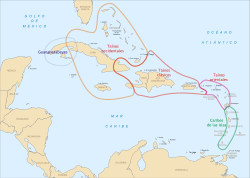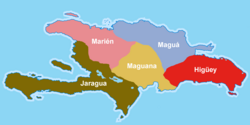Taíno

The Taínos are an indigenous people that have lived in the Americas before Columbus arrived there. They came from the Caribbean coast of South America. Around 1200 CE, they moved northward to the island chain of the Lesser Antilles and the Greater Antilles.
When Christopher Columbus came to the Americas, the Taínos were living in the Bahamas, the Greater Antilles (Cuba, Jamaica, Hispaniola and Puerto Rico), and some islands of the northern Lesser Antilles. Their culture was different from the culture of the Arawak people (another indigenous group of South America). They were the first people that the Spanish met in the Americas.
Name
The name Taíno was given by Columbus. When he met some native men, they said "Taíno, Taíno", meaning "We are good, noble". Columbus thought that taíno was the name of the people.[1]
Rouse divides the Taínos into three main groups. One is the Classic Taíno, from Hispaniola and Puerto Rico. Another is the Western Taíno or sub-Taíno, from Jamaica, Cuba (except for the western tip of the island) and the Bahamas. The third is the Eastern Taíno, from the Virgin Islands to Montserrat.[2]
The Taínos of the Bahamas were known as the '"Lucayan". (At that time, the Bahamas were called the Lucayas). Lucayos were Taínos, but their culture was less developed. Archeologists call them "sub-Taínos".
Origins
The Taínos' ancestors went from the center of the Amazon Basin to the Orinoco Valley. From there, they went through Guyana and Venezuela and got to the Caribbean islands.[2]
A different theory says that the Taínos' ancestors came from the Colombian Andes.[2]
The Taíno culture developed in the Greater Antilles.
Culture and lifestyle
Taíno society is divided into two classes. There are the naborias (common people) and the nitaínos (nobles). Both classes are governed by chiefs known as caciques. The caciques could be either male or female. There are also bohiques (medicine men).[3]
The Taínos lived in villages called yucayeques. The villages in the Bahamas were the smallest. The Taínos built large round houses called bohio, where several families lived. The cacique and his family lived in a rectangular house called caneye. People slept on cotton hammocks (hamacas).[4]
The Taínos often played a ball game called batos. Batey was also the name of the place where they played and had dances. The cacique sat on a chair of wood called duho, or dujo.[4]
Taíno Media
Reconstruction of a Taíno village in El Chorro de Maíta, Cuba
The Guanahatabey region in relation to Taíno and Island Carib groups
Some Taíno women are preparing cassava bread in 1565: grating yuca roots into paste, shaping the bread, and cooking it on a fire-heated burén
Cayetano Coll y Toste's 1901 map of Puerto Rico caciques
Cassava, starchy (yuca) roots, the Taínos' main crop
Piedra Escrita on River Saliente in Jayuya, Puerto Rico
Taíno zemí sculptureWalters Art Museum
References
- ↑ Anglería, Pedro Mártir de (1949). Décadas del Nuevo Mundo (in Spanish). Buenos Aires: Editorial Bajel.
{{cite book}}: CS1 maint: unrecognized language (link) - ↑ 2.0 2.1 2.2 Rouse, Irving (1992). The Tainos: Rise and Decline of the people who greeted Columbus. New Haven: Yale University Press. ISBN 0300056966.
- ↑ "Caciques, nobles and their regalia". elmuseo.org. Archived from the original on 2006-10-09. Retrieved 2008-02-29.
- ↑ 4.0 4.1 Fernández de Oviedo y Valdéz, Gonzalo (1959). Historia General y Natural de las Indias (in Spanish). Madrid: Biblioteca de Autores Españoles.
{{cite book}}: CS1 maint: unrecognized language (link)









